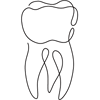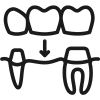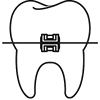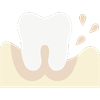Implantology

Dental implant treatment is a popular and effective solution for people who have lost one or more teeth due to injuries, cavities or other factors and want to restore their smile and dental function.
What does dental implant treatment involve?
Dental implant treatment is a dental procedure that involves placing artificial tooth roots (dental implants) in the jawbone. Dental implants support replacement teeth.
How is the procedure performed?
The procedure is usually performed under local anesthesia and involves a surgical process of inserting the implant into the bone. After the implant is placed, it is allowed to heal and fuse with the surrounding bone tissue over a period of several months.
Once the implant has fully integrated with the bone, a custom-made replacement tooth (such as a crown, bridge, or denture) can be attached to it.
Dentoalveolar Surgery

Dentoalveolar surgery is a type of dental treatment that involves surgical procedures on the teeth and surrounding tissues, such as the gums and jawbone.
What does dentoalveolar surgery entail?
This type of surgery can be used to remove teeth that are affected or damaged, to treat gum disease, to prepare the mouth for orthodontic treatment or to place dental implants.
During the procedure, a dental surgeon will numb the area with a local anesthetic and make incisions in the gum tissue to access the tooth or area of concern. They can remove any damaged or infected tissue, extract a tooth if necessary or reshape the jawbone to prepare it for an implant.
What is the recovery time from this treatment?
Recovery time will depend on the extent of the surgery and the individual patient, but most people can return to their normal activities within a few days to a week.
Endodontics

Endodontics is an important and effective treatment to save an affected tooth and prevent complications that can occur if the problem is neglected.
Endodontic treatment addresses issues that affect the dental pulp, which is the soft and nerve-rich interior of the tooth. These problems include deep cavities, dental fractures, or injuries caused by trauma.
What does the endodontic procedure entail?
The endodontic procedure involves removing infected or damaged pulp and cleaning the root canal (the canal through which the pulp passes from inside the tooth to the jawbone or jawbone).
After cleaning the root canal, it is filled with a special material to prevent further infections and protect the tooth structure.
What does endodontic treatment involve?
The endodontic procedure is usually performed under local anesthesia and can be completed in one or more sessions, depending on the complexity of the case.
After completing the treatment, it may be necessary to apply a crown or other protection to the tooth, in order to safeguard it and restore its function.
Dental Prosthetics

Dental prosthetics are important for improving the aesthetic appearance of the teeth and for restoring masticatory function.
It can also be helpful in preventing other dental problems and improving the patient's quality of life.
What does the dental prosthetic procedure involve?
Dental prosthetics is a branch of dentistry that deal with the restoration of damaged or lost teeth through the application of dental prostheses or dental crowns.
The dental prosthetics procedure involve evaluating the condition of the teeth and the individual needs of the patient, as well as preparing the teeth for the application of dental prostheses or dental crowns.
The process of manufacturing dentures or dental crowns can be done in the laboratory or using modern computer technology.
What are dental prostheses?
Dental prostheses are artificial devices designed to replace missing or damaged teeth. They can be used to replace a single tooth, multiple teeth, or even an entire dental arch.
How many types of dental prostheses are there?
There are different types of dentures, including fixed or removable dentures, partial or full dentures, depending on the needs of the patient.
Dental crowns are fixed dental prostheses that cover a damaged or weakened tooth to protect it and restore its function. They are often used to protect a tooth after a root canal treatment or to improve the aesthetic appearance of the teeth.
Orthodontics

Orthodontics is a branch of dentistry that deals with the prevention, diagnosis and treatment of dental and jaw abnormalities in order to improve the functionality and appearance of the teeth.
Dental abnormalities can include misaligned teeth, large spaces between teeth, incorrect bite and other teeth or jaw alignment problems.
These issues can lead to the development of dental cavities, gum problems, or maxillary joint issues.
What does orthodontic treatment involve?
Before beginning orthodontic treatment, the patient must be evaluated by an orthodontist. The evaluation includes oral examination, radiographic evaluation and bite evaluation.
Based on the evaluation, the orthodontist will create a personalized treatment plan.
The orthodontic treatment involves the use of braces to correct abnormalities of the teeth and jaws.
Braces can be either fixed (braces and springs) or removable (aligners, functional braces or retainers).
The duration of the orthodontic treatment can vary depending on the severity of the issue and the type of braces used.
By properly aligning your teeth and jaws, you can benefit from a better bite, easier teeth cleaning and more confidence in your smile.
Pediatric Dentistry

Pedodontics is an important branch of dentistry that focuses on the dental care of children, starting from newborns to teenagers.
In addition to pedodontic treatments, the dentist offers advice on eating habits and oral hygiene, as well as the correct use of toothpaste and dental floss.
What pedodontic treatments can my child benefit from?
Treatment or procedures in pedodontics include:
Dental examination
During the examination, the pediatric dentist will examine the child's teeth and assess the general state of dental health.
Dental cleaning
During this procedure, plaque and tartar are removed from the teeth to prevent tooth decay and gingivitis problems.
Application of fluoride
Fluoride is an important mineral for tooth development, and the pediatric dentist may apply a thin layer of gel or liquid to the teeth to prevent tooth decay.
Caries treatment
If a child develops tooth decay, the pediatric dentist can remove the decay and fill the cavity with a special material.
Sealing the teeth
This procedure involves applying a thin layer of protective material to the surface of the teeth to prevent dental cavities.
Orthodontic treatment
The pediatric dentist can treat teeth and jaw alignment problems using special braces.
Dental extraction
If a tooth is severely damaged and cannot be saved, the pediatric dentist can extract that tooth.
Pedodontics also involves educating parents and children about oral hygiene and the importance of maintaining healthy teeth.
Prophylaxis

Dental prophylaxis involves a set of procedures and practices that prevent dental disease and maintain oral health.
What does dental prophylaxis entail?
The main purpose of prophylaxis is to prevent the accumulation of bacterial plaque on the surface of the teeth and gingival inflammation, which can lead to tooth decay, periodontitis and other dental diseases.
Dental prophylaxis involves procedures such as regular tooth brushing, flossing, tongue cleaning, professional brushing, or fluoride application.
Patients are also educated about oral hygiene and the importance of maintaining healthy teeth. This may include advice on healthy eating and oral hygiene habits.
How often should I go to the dentist?
It is recommended to visit the dentist at least once every six months for professional brushing and general assessment of oral health.
By adopting an appropriate dental prophylaxis regimen, you can prevent the development of dental disease and maintain healthy teeth in the long term.
Odontotherapy

Odontology is a branch of medicine that focuses on the diagnosis and treatment of dental and oral cavity problems. This involves a wide range of procedures, from simple periodic check-ups to complex treatments and dental restorations.
What does odontotherapy entail?
the treatment focuses on caries and gingivitis, but also on more serious conditions. Odontotherapy can range from regular cleaning of the teeth and gums, to treating tooth decay, tooth extractions, root canals and even surgery.
It is important to note that dental treatment is not limited to existing dental problems, but also plays an important role in preventing them, by promoting proper dental hygiene and educating patients about healthy eating and oral hygiene habits.
Dental Aesthetics

Dare to dream of a perfect smile and let cosmetic dentistry help you achieve a milion-dollar smile!
When you are happy with the appearance of your smile, you are more confident and open in social and professional interactions.
Dental aesthetics can improve your smile and restore your self-confidence!
From teeth whitening and veneers to dental implants and orthodontics, there are a wide range of options available to transform the appearance and functionality of your teeth.
These procedures can help improve the alignment, shape, color, size, and proportions of the teeth, as well as the gingival aspects that significantly influence the overall appearance of the smile.
No matter what's bothering you about your smile, there's no problem too big that we can't fix.
Our dental esthetics professionals can offer you a customized solution to achieve the beautiful and healthy smile you've always dreamed of.
Periodontology

Periodontology is a branch of dentistry that focuses on the health and treatment of the tissues that support the teeth, such as the gums, ligaments, and alveolar bone. Periodontal problems are caused by inflammation and infection of the tissues surrounding the teeth, which can lead to tooth loss and damage to soft tissue and bone.
What does periodontal treatment entail??
Periodontal treatment may include non-surgical therapy, such as professional cleaning and scaling, or surgical therapy, such as surgery to remove damaged tissue or implant new tissue.

